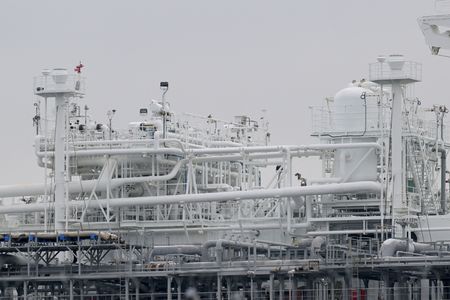(Reuters) -Germany has looked to liquefied natural gas (LNG) imports to replace piped Russian gas since Moscow’s invasion of Ukraine in 2022.
Its first move has been to deploy floating storage regasification units (FSRUs) to receive seaborne LNG, while longer term it plans shore-based regasification terminals and facilities to import and produce ammonia and green hydrogen.
Below are details of the latest developments:
MUKRAN
The terminal on Ruegen island in the Baltic Sea supplies onshore grids with LNG via pipeline firm Gascade’s new OAL pipeline.
On April 16, private operator Deutsche ReGas reported that there are no more regasification slots available at Mukran for the remainder of 2025, saying LNG carriers are arriving on a weekly basis with around one terawatt hour of gas each.
This comes after ReGas cancelled one of the two FSRUs, the Energos Power, in February, due to low utilisation.
It now only employs Norwegian operator Hoegh’s FSRU Neptune, having said it struggled with fees offered by state-owned Deutsche Energy Terminal GmbH (DET) to attract cargoes at DET-supervised North Sea terminals.
However, gas demand was set to be strong ahead of next winter, said ReGas, also citing EU decisions to extend requirements to refill underground storage facilities.
Looking long-term, on April 4, ReGas launched a three-month bidding round for expanding Mukran’s capacity by offering an additional 5 bcm per year from 2027 to 2043. It wants to restart a second FSRU and restore full capacity of 13.5 bcm by 2027.
LUBMIN
ReGas and Hoegh in June 2024 signed an agreement to develop the Baltic Sea port, a forerunner of Mukran, into an ammonia/hydrogen import terminal.
STADE
Hanseatic Energy Hub (HEH) in 2024 took a final investment decision for a land-based, ammonia-ready terminal at the Elbe river inland port to start in 2027.
The terminal is expected to cost around 1 billion euros ($1.14 billion).
Employment of the FSRU Energos Force, that was expected to run until 2027, ahead of the onshore terminal starting operations, is delayed until further notice after DET and HEH cancelled contracts with each other over unresolved disputes about construction schedules and payments.
WILHELMSHAVEN
Utility Uniper launched Germany’s first FSRU operation, Wilhelmshaven 1, on the North Sea, in 2022.
Uniper plans to add a land-based ammonia import reception terminal and cracker in the second half of this decade to make green hydrogen, and build a 200 MW electrolyser to be fed with local wind power.
DET said there are plans for a second FSRU at Wilhelmshaven but has not specified a commissioning date.
BRUNSBUETTEL
The Brunsbuettel FSRU went into operation in 2023 on the North Sea coast, initially chartered and operated by utility RWE’s trading arm before it was handed over to DET.
It is the forerunner of a land-based LNG facility which has been cleared to receive 40 million euros of state support.
It could start operations at the end of 2026, when a newly inaugurated, adjacent ammonia terminal could also start up.
($1 = 0.8798 euros)
(Reporting by Vera Eckert; Editing by Aidan Lewis, Jason Neely, Philippa Fletcher)










